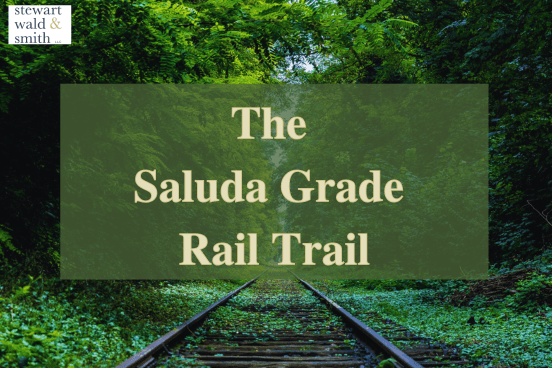
If you live in or near upstate South Carolina or Western North Carolina, you’ve likely heard of the Saluda Grade Trail or the Saluda Grade Railroad. You may know the history of the railway and have heard about the potential for a new recreational trail. You may be a landowner near the proposed recreational trail and have questions about the plan for the trail, the rights you have as a property owner, or the effect the trail may have on your property.
Stewart, Wald & Smith is a rails-to-trails law firm that solely practices in the area of helping landowners recover money for land that is taken to create recreational trails. We hope that many of your questions will be answered below. If you are a landowner and will be affected by the Saluda Grade Rail Trail, contact our firm to discuss the specifics of your case.
History of the Saluda Grade Railroad
In the 1870’s, the Saluda Grade Railroad system was built as a means of connecting Spartanburg, South Carolina, and Asheville, North Carolina. If you are familiar with this area of the country, then you know that this is not an easy landscape for building a rail system. From an engineering and railroading perspective, the Saluda railway was one of the scariest and most daunting sections of the mainline anywhere in the country.[1] The railway remained in operation until late 2001.
Interesting Facts:
The railroad line had an average grade of 4.2% and a maximum grade of 5%
Trains were often required to cut the train into two sections to successfully complete this portion of the railway (done in both directions due to the grade’s severity)[2]
The railway has not been used since 2001 and is now in the process of being converted to the Saluda Grade Rail Trail.
The Plan for A Recreational Trail
Three Carolina-based non-profit organizations have joined together to lead the effort to create the Saluda Grade Trail: Conserving Carolina (NC), Play, Advocate, Live Well (SC), and Upstate Forever (SC). These organizations are looking to purchase the railroad corridor, have submitted an offer to purchase the rail corridor, and are in the process of negotiations.
The proposed recreational trail would run from Inman, South Carolina to Zirconia, North Carolina. The route would run an estimated 31 miles; 16 miles in South Carolina and 15 miles in North Carolina. The trail could be used for walking, running, biking, adaptive mobility, and other compatible modes of recreation.[3] The trail is planned to pass through the towns of Inman, Gramling, Campobello, Landrum, Tryon, and Saluda.[4]
Who determines if the rail corridor can become a trail?
The Surface Transportation Board, the federal agency that oversees railroads, has the ability to authorize the conversion of railroad rights-of-way to recreational trails. This concept is known as “railbanking.” Although railbanking is intended to “preserve” the line for potential railroad use, effectively, it permanently converts the railroad right-of-way to a linear recreational space.
The Trails Act, an Act of Congress enacted in 1963 and amended in 1983, governs this process and seeks to preserve these railroad corridors.
To learn more about the Trails Act, please read our Landowners’ Guide to the Trails Act.
What if part of my property is acquired to create the trail?
If your property is directly adjacent to this proposed trail, you may have a Trails Act claim. Most landowners are unaware of their property rights when it comes to the railroad’s right of way. You may assume that the railroad owns the land along the corridor, but actually, title research often shows that the adjoining landowner is the owner of the land in the corridor. If a court agrees with us that this is true, then you very likely will be able to obtain compensation from the government for a taking of land.
To be compensated, you as the landowner need to file a lawsuit against the federal government. These cases are unique because they are considered “inverse condemnation,” and the landowner must affirmatively bring a claim against the government for just compensation.
These cases’ require legal counsel that is skilled and experienced in this area of law. Our firm is passionate about these cases and is the only firm in the nation that practices solely in this area. Our team’s experience, expertise, and understanding of the laws associated with these cases have allowed us to recover over $380 Million for landowners in Rails-to-Trails litigation.
If you own land along this abandoned corridor contact our firm today. You will be able to speak with one of our attorneys who will help you understand your rights and help you determine the best way to proceed with your case.
Does filing a claim mean that I am opposing the creation of the Saluda Grade Trail?
No, your claim is not adverse to the creation of the Saluda Grade Trail or the organizations seeking to create the trail. Your claim is neutral towards the trail and its creators and operators. Your case would be against the federal government and would simply ask the government to pay you just compensation for the land that was taken.
[1]https://www.american-rails.com/saluda-grade.html
[2]https://www.american-rails.com/saluda-grade.html
[3]https://conservingcarolina.org/saluda-grade-faqs/#vision-for-sgt

